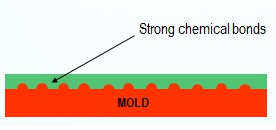Article
Semi-Permanent Mold Release Agents
May 31 2022 at 09:16am
Semi-Permanent Mold Release Agents
Release agents are used for preventing parts from sticking to the mold or fixture, regardless of the process. High performance release systems are prescribed for rate production processes. Much like Teflon™ coating a pan, semi-permanent mold release systems are in fact cured polymers that are bonded to the mold surface. These materials are not wax! They are designed to minimize or eliminate transfer to the part.
|
|
|
|
|
|
|
|
|
A typical semi-permanent system is made up of two different polymer coatings:
1. Tool sealer coat to fill the micro-porous sites on the tool surface (reducing mechanical attachment).
2. Low-energy release agent to prevent chemical attachment
These materials work best when applied in very thin layers. Application procedures generally require that the materials be sprayed or wiped sparingly onto the tool surface. The desired result is to have the least amount of release agent on the surface that will do the job. This reduces the possibility that the release polymer will transfer to the part surface during the molding operation. Worse yet, the release polymer can act like an adhesive when it is over-applied or under-cured. This sometimes results in the part sticking to the tool and perhaps damaging both the part and the tool upon demolding. Thus, proper application procedures are crucial for good performance.
A semi-permanent release agent is designed to provide multiple releases. Typically, 2 - 10 parts can be molded from a properly treated surface prior to reapplication of the release agent. Some end-users choose to re-apply the release coat every molding cycle. While this is thought to ensure a good release, it adds to quicker build-up and possible transfer problems in production. After a certain number of applications, it is recommended that the release agent be stripped back to the sealer coat and reapplied. This is necessary for long-term release performance without release transfer. Most manufacturers will set up regular maintenance intervals between 20 and 50 application cycles, to strip and reapply the release system depending on the tooling and the material system used.
Semi-permanent release systems are available in both solvent and solvent-free (water-based) formulas. Many manufacturers are choosing to use the solvent-free, non-VOC formulas in lieu of the old solvent-based materials to reduce health and safety risks and other environmental concerns that solvents cause.
Compiled from Dorworth, L. C., Gardiner, G. L., & Mellema, G. M. (2019). Essentials of advanced composite fabrication and repair
And Axel Plastics
By Neotech Composites Co.,Ltd.

